An Embroidered Chikankari Georgette Kurti is an elegant and timeless piece of ethnic wear that combines the beauty of traditional Chikankari embroidery with the lightweight, flowy fabric of Georgette. This kurti is perfect for adding a refined, cultural touch to your wardrobe. Here’s a detailed breakdown of what you can expect from this type of kurti:
1. Fabric and Material
- Georgette: Georgette is a lightweight, semi-transparent fabric that has a slightly crinkled texture, making it flow beautifully and drape well. It’s often used for formal or semi-formal wear due to its graceful appearance. Georgette is perfect for both warm and cool weather as it’s breathable and keeps you comfortable while looking stylish.
- Chikankari Embroidery: Chikankari is an ancient form of hand-embroidery originating from Lucknow, India. The embroidery is typically done with white thread on light-colored fabrics, though it can be found in various colors as well. The intricate and delicate stitches are often floral or paisley designs, making the kurti look rich, detailed, and intricate.
2. Design and Embroidery
- Chikankari Embroidery: This type of embroidery involves a variety of techniques, such as Murri, Bakhiya, Phanda, and Zardozi, giving the fabric a textured and ornate look. The embroidery is usually done by hand, making each piece unique.
- Floral Motifs: Chikankari designs often feature delicate floral patterns, with roses, daisies, and leaves adding a traditional and feminine touch to the kurti.
- Paisley or Geometric Patterns: Some kurtis may feature paisley or geometric designs, lending a more structured and modern look while retaining the traditional charm of Chikankari.
- Placement: The embroidery can be placed strategically on the neckline, sleeves, bodice, and sometimes around the hemline or on the entire front of the kurti. The placement and intensity of the embroidery determine how festive or casual the kurti will look.
- Contrast Threadwork: While white threadwork on pastel or soft-colored fabrics like cream, ivory, beige, and light blue is traditional, modern variations may use colored threads or metallic embroidery (such as gold or silver) for a more vibrant and glamorous look.
3. Silhouette and Fit
- Straight Cut: Many Chikankari kurtis are designed in a straight-cut silhouette, which is classic, comfortable, and flattering on most body types. The straight cut ensures that the kurti hangs gracefully without being too tight or too loose.
- A-Line: Some Chikankari kurtis are also available in an A-line cut, which flares gently from the bust down to the hem, providing a more feminine shape.
- Length: These kurtis usually fall just above or around the knee but may vary in length depending on the style. Longer versions may extend to mid-calf or even ankle-length for a more traditional look.
- Fit: The fit of an embroidered chikankari kurti can range from loose and relaxed to slim fit. The choice depends on the desired style – a loose fit offers comfort and a more casual vibe, while a slim fit can look more polished and refined.
4. Neckline and Sleeves
- Neckline:
- Round Neck: A simple and classic round neckline is common in Chikankari kurtis, offering a clean, timeless look.
- V-Neck: A flattering option that elongates the neck and provides a more elegant appearance, suitable for semi-formal or festive occasions.
- Keyhole Neckline: A small cut-out at the neck, often embellished with embroidery, adds a modern, stylish twist to the kurti.
- Collared Neck: Some designs feature a Mandarin collar or notch collar, providing a structured, polished look.
- Sleeve Styles:
- Three-Quarter Sleeves: This is the most common and versatile sleeve style for a chikankari kurti. It offers enough coverage while still looking fresh and comfortable.
- Full Sleeves: A full sleeve style may be chosen for a more formal or traditional look, often highlighting the Chikankari embroidery along the sleeve edges.
- Short Sleeves: In warmer climates or casual settings, short sleeves can provide a breezy, light look.
- Sleeveless: Some modern Chikankari kurtis come sleeveless, giving them a more contemporary and chic vibe.
5. Occasions to Wear
- Festivals and Special Occasions: Due to the luxurious and detailed nature of Chikankari embroidery, this kurti is perfect for festivals like Diwali, Eid, or Navratri. Pair it with palazzo pants, churidar, or a long skirt for an elegant look.
- Weddings and Celebrations: The intricate embroidery makes it suitable for weddings, engagement parties, or other traditional ceremonies.
- Casual Wear: Depending on the print, a Chikankari georgette kurti can also be worn for more casual occasions, like family gatherings or day outings. Pair it with leggings or jeans for a more laid-back look.
- Office Wear: For a more professional and understated look, choose a kurti with subtle embroidery and pair it with trousers or palazzo pants.
- Evening Wear: Dress up the kurti with statement jewelry and heels for an evening out or dinner with friends.
6. Styling Tips
- Bottom Wear:
- Churidar: Traditional and elegant, churidars complement the chikankari kurti and give a sleek, fitted look.
- Leggings: For a more modern and comfortable pairing, black leggings or contrasting colored leggings can be worn.
- Palazzo Pants: For a flowy and relaxed style, palazzo pants work beautifully with the delicate texture of georgette.
- Skirt: For a more ethnic and bohemian look, you can pair the kurti with a long, flared skirt.
- Footwear:
- Traditional Juttis or Mojaris: These ethnic shoes complement the kurti, adding to the cultural charm.
- Heels or Block Heels: For a more formal look, block heels or pumps add elegance and height.
- Flats: Comfortable yet stylish, flat sandals work well with both casual and semi-formal looks.
- Jewelry:
- Oxidized Jewelry: Oxidized earrings, necklaces, or bracelets add a rustic, vintage touch to the kurti.
- Gold or Silver Jewelry: A more minimalist approach with thin gold or silver jewelry will keep the attention on the embroidery.
- Statement Earrings: Large jhumkas or chandbalis add a festive vibe and can dress up the kurti for special occasions.
- Accessories:
- Dupatta: A contrasting or matching dupatta can enhance the look, especially for formal or festive occasions.
- Handbag: A small clutch or ethnic handbag can complement the outfit, adding practicality without sacrificing style.
- Scarf or Stole: In cooler weather, a light scarf or stole can provide additional warmth while maintaining the style of the kurti.
7. Care and Maintenance
- Washing: Since Chikankari embroidery is delicate, handwashing or dry cleaning is recommended. If machine washing is necessary, do so on a gentle cycle with cold water.
- Ironing: Iron the kurti on low heat with a cloth over the embroidery to protect the intricate stitches. Avoid direct heat on the embroidery to prevent any damage.
- Storage: Store your kurti in a garment bag to protect the embroidery from dust, dirt, and snagging. Hanging the kurti can prevent wrinkles and preserve the shape.
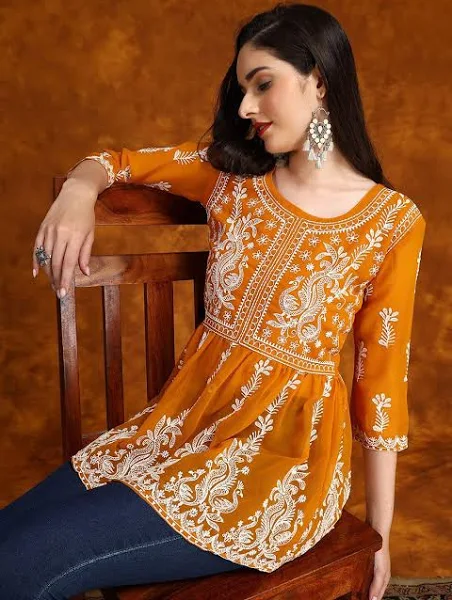
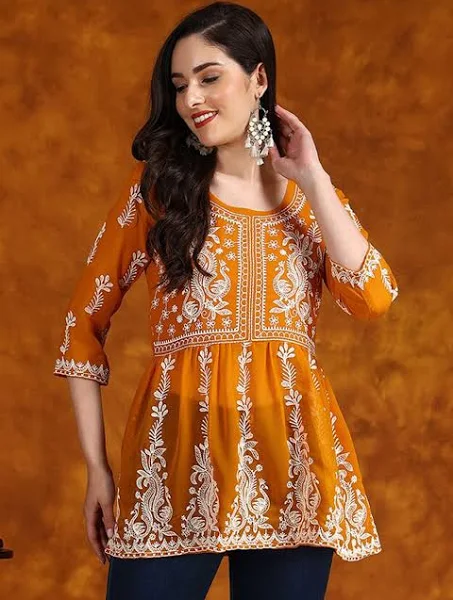
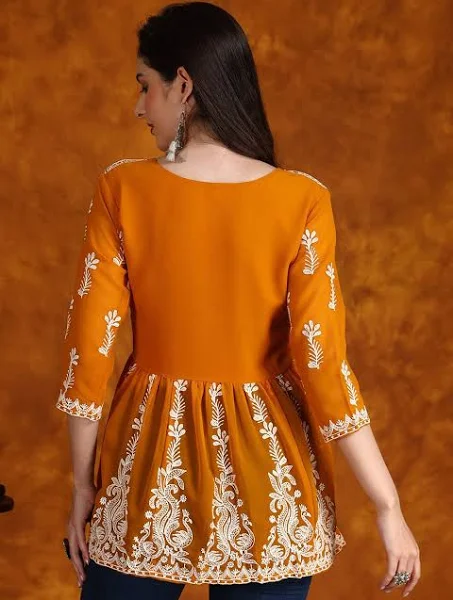
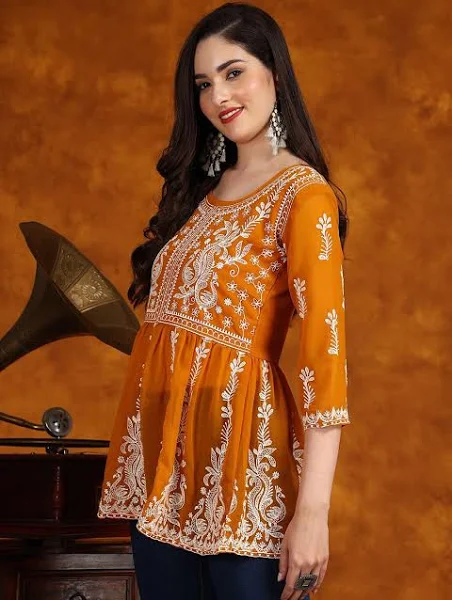
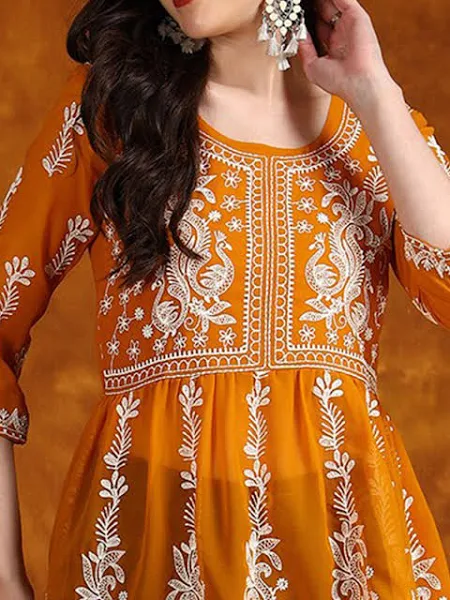
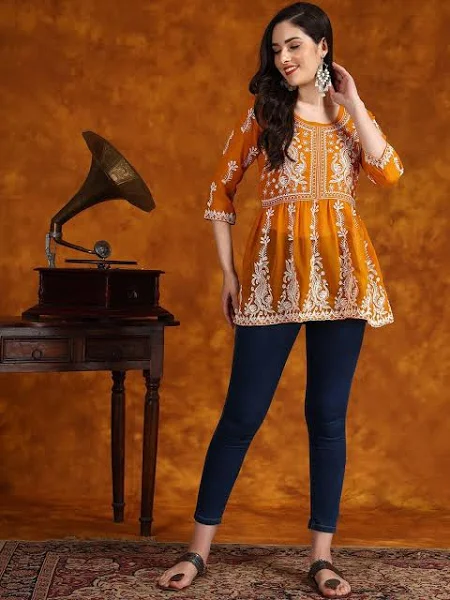
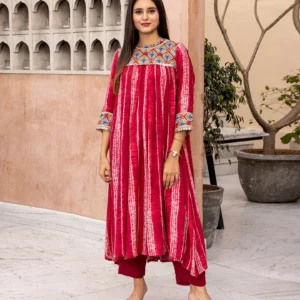
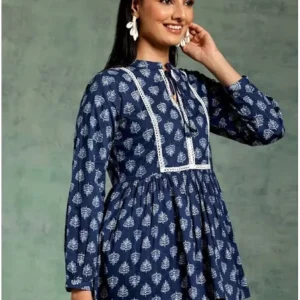
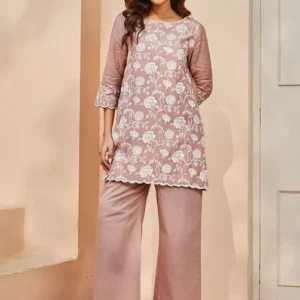
Reviews
There are no reviews yet.